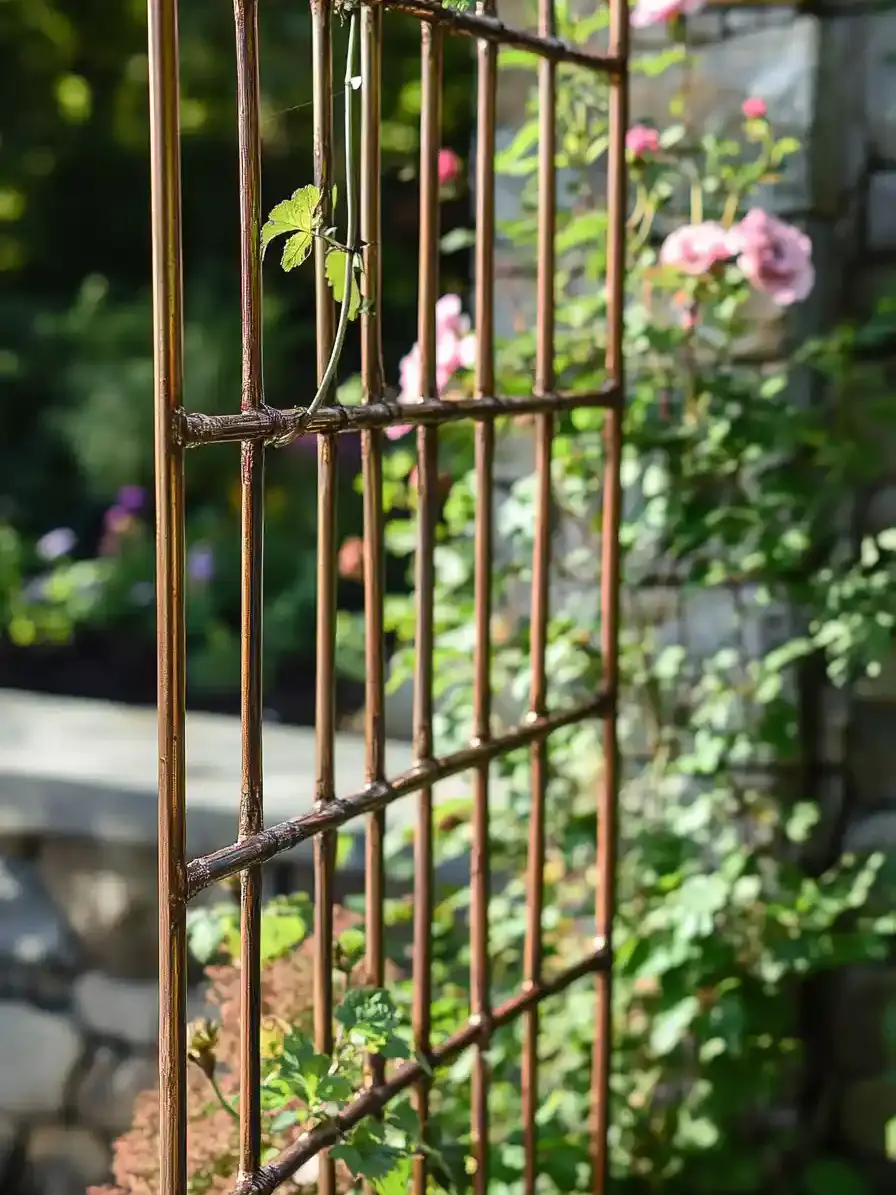If you’ve ever had a climbing plant swallow your patio chair or watched your tomatoes topple under their own weight, you know the value of a good trellis. I learned this the hard way after my first attempt at a DIY trellis—a flimsy contraption made of twine and blind optimism—collapsed under a modest morning glory. It was equal parts hilarious and heartbreaking.
That little garden fail sent me on a mission: I wanted to build trellises that were not only functional but stylish, affordable, and easy to maintain. I was looking for something that could handle the weight of my ambitious plantings, wouldn’t fall apart in a single season, and ideally, wouldn’t cost a fortune.
What I discovered was a world of creative and practical DIY trellis solutions—many of which can be built with materials you already have lying around. Whether you’re supporting cucumbers, climbing roses, or sweet peas, these innovative designs bring both structure and beauty to your garden.
1. Copper Pipe Trellis
Materials Needed:
- Copper pipes (½ or ¾ inch)
- Copper fittings (elbows, tees)
- Pipe cutter
- Optional: Soldering kit or epoxy for extra strength
Why It Works:
If you’re looking to add a modern, industrial touch to your garden, a copper pipe trellis is a total game-changer. Not only is it sturdy enough to support heavy climbers like squash or cucumbers, but copper also naturally develops a beautiful patina over time—giving it a weathered, elegant charm.
This trellis can be customized to any shape or size, from minimalist vertical bars to geometric grids. While soldering the joints will give you a rock-solid structure, strong adhesive or simple pressure fittings often do the trick just fine for most backyard applications.
Pro Tip: Anchor it into the ground using rebar or concrete bases to keep it steady in windy weather.
2. Pallet Trellis
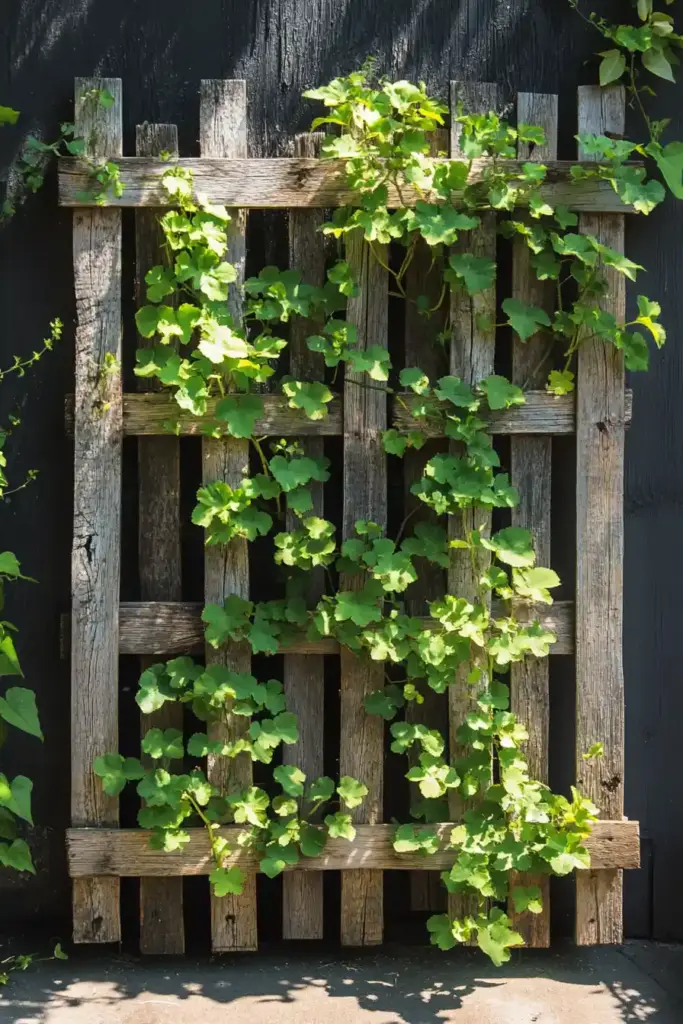
Materials Needed:
- Wooden pallet (heat-treated and clean)
- Sandpaper
- Optional: Paint or wood stain
- Screws or garden stakes (for support)
Why It Works:
Pallets are the unsung heroes of the DIY world—and in the garden, they shine as a quick, eco-friendly trellis option. Whether you lean one upright against a fence or hinge two together for a freestanding A-frame, pallets provide a sturdy structure that’s perfect for lighter climbers like peas, beans, or sweet peas.
Beyond their utility, pallet trellises bring rustic charm to small garden spaces or patios. With a little sanding and a splash of paint or stain, they can be made to blend in or stand out, depending on your garden style.
Pro Tip: Make sure the pallet is labeled “HT” (heat-treated) rather than chemically treated—your plants will thank you!
3. Wire Mesh Trellis
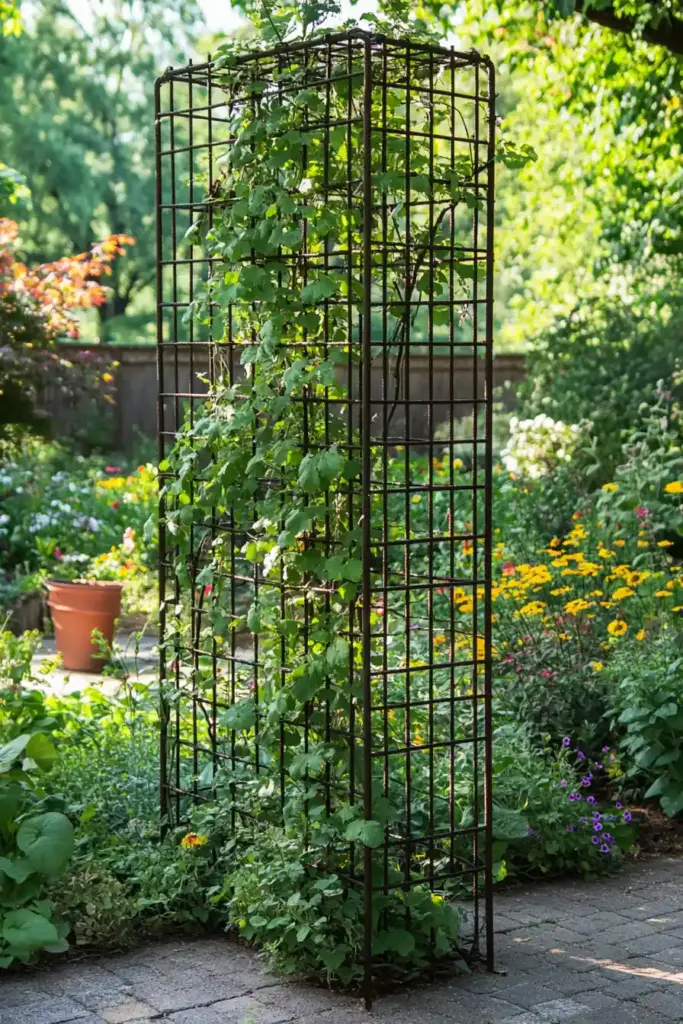
Materials Needed:
- Galvanized wire mesh panel (hardware cloth or livestock panel)
- Wooden or metal frame
- Staples, zip ties, or wire for fastening
- Mounting hardware or stakes
Why It Works:
The wire mesh trellis is a classic for a reason—it’s tough, versatile, and fantastic for vegetables like tomatoes, cucumbers, and pole beans. The grid layout gives climbing plants plenty of grip, while the open design keeps air flowing freely, helping to prevent mildew and pests.
When mounted inside a wood or metal frame, this trellis can be customized for vertical growing, angled lean-tos, or even tunnel walkways for dramatic garden entrances. And if you go with galvanized mesh, you’ll have a rust-resistant setup that lasts for seasons.
Pro Tip: Install the mesh trellis along a sunny fence line to give plants light and structure in one smart move.
4. PVC Pipe Trellis

Materials Needed:
- PVC pipes (½ or ¾ inch diameter)
- PVC fittings (elbows, tees, crosses)
- Netting, mesh, or garden twine
- Pipe cutter or handsaw
Why It Works:
Lightweight, affordable, and endlessly customizable, PVC is a go-to material for gardeners who like to build smart. A PVC pipe trellis is especially great for seasonal gardens—easy to assemble, move, or disassemble when needed. And since PVC stands up to moisture and UV rays, it won’t warp or rot like wood.
You can design it as a simple vertical frame, a domed arch, or even a tunnel for dramatic effect. Add mesh or tie garden twine in a criss-cross pattern, and you’ve got a plant-friendly climbing surface that’s strong enough for beans, peas, and even melons (with a little support).
Pro Tip: Spray-paint the PVC pipes to match your garden aesthetic or blend in with the foliage.
5. Freestanding Ladder Trellis
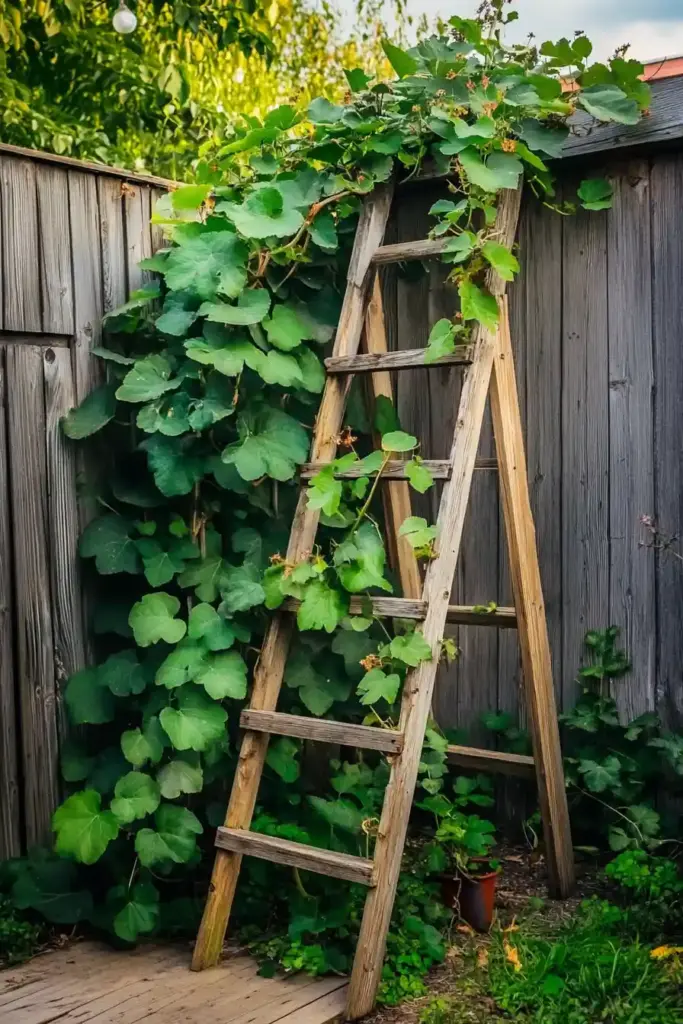
Materials Needed:
- Two wooden ladders (matching height)
- Hinges (or a chain to control the angle)
- Optional: Paint or wood stain
- Screws or stabilizers (if needed for wind)
Why It Works:
If you’ve got an old ladder lying around—or can grab a pair from a flea market—you’re halfway to building a charming freestanding ladder trellis. It’s ideal for flowering vines like morning glories, clematis, or even mini gourds. Simply hinge two ladders together at the top, open them like an A-frame, and plant your climbers at the base.
Ladders give a bold vertical element to garden beds and work great in pots too. Their rungs make perfect natural supports, and the space in between allows for great airflow and easy plant access.
Pro Tip: Add a wooden board across the top as a shelf for small pots, lanterns, or trailing plants to increase visual interest.
6. Chevron-Patterned Trellis
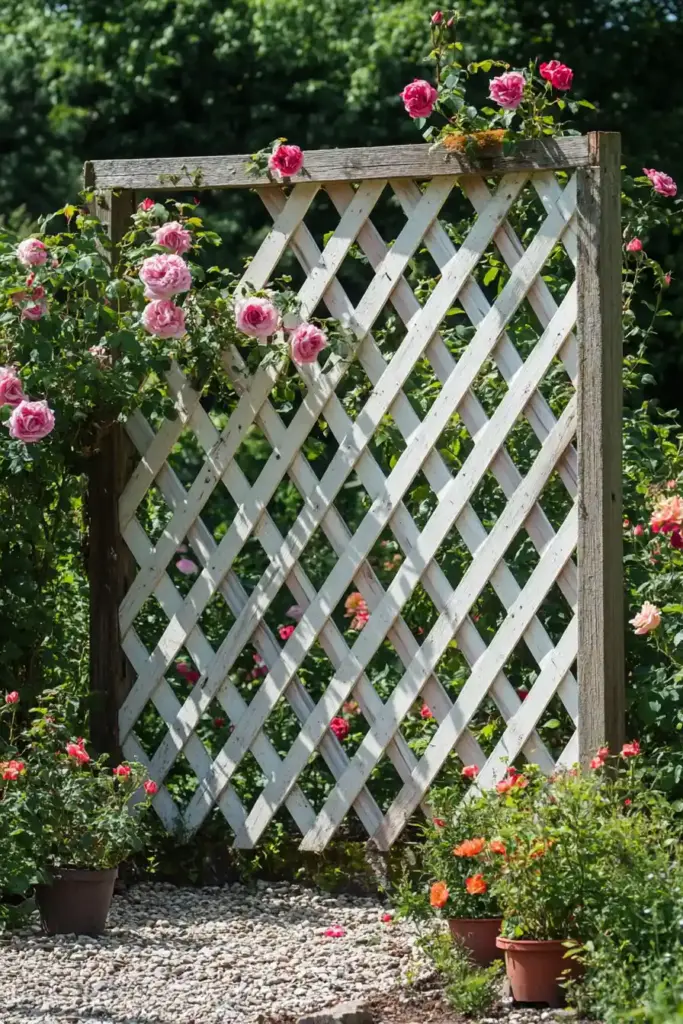
Materials Needed:
- Wooden slats (1×2 or similar size)
- Nails or screws
- Wood glue
- Saw and measuring tape
- Optional: Wood stain or outdoor paint
Why It Works:
For gardeners who want their vertical supports to double as art, a chevron-patterned trellis delivers both function and flair. This decorative design adds a bold, modern touch to fences, walls, or raised beds while offering ample support for lightweight climbers like ivy, jasmine, or nasturtiums.
Arranging wooden slats in a repeating V-shape creates a visually striking zigzag pattern that naturally encourages upward plant growth. It’s also a great project for DIYers who enjoy precise measuring and a bit of carpentry fun.
Pro Tip: For best results, assemble the trellis on a flat surface before mounting it—this ensures even spacing and a clean final look.
7. Repurposed Bicycle Wheel Trellis
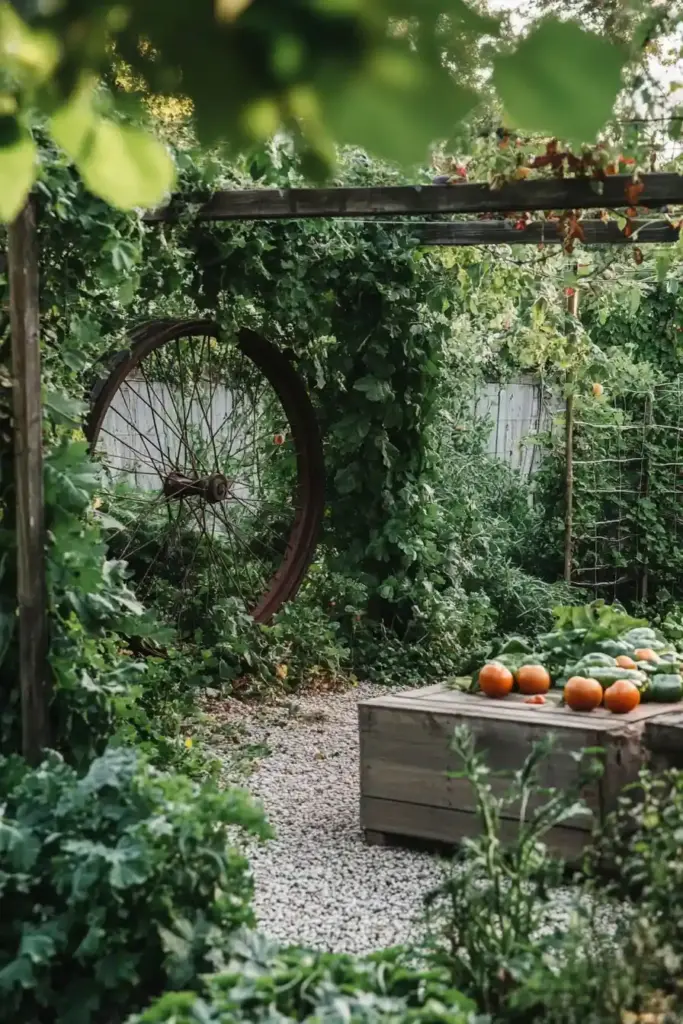
Materials Needed:
- Two or more old bicycle wheels
- A sturdy wooden or metal post
- Drill, bolts, or heavy-duty wire
- Optional: Paint or rust protection spray
Why It Works:
This upcycled trellis is a showstopper for gardeners who love quirky, sustainable design. Bicycle wheels, with their built-in spokes, make the perfect circular climbing surface for tendrils to grip. Mounted vertically on a post, they create a striking kinetic sculpture that supports lightweight vines like sweet peas, morning glories, or black-eyed Susan vines.
It’s an unexpected and playful garden feature—perfect for pollinator patches, cottage-style gardens, or as a standalone trellis tower. And because you’re reusing materials, it’s a feel-good project for the environment too.
Pro Tip: Space the wheels a few inches apart for a layered effect that gives more room for plants to sprawl and twine.
8. Bamboo Teepee Trellis
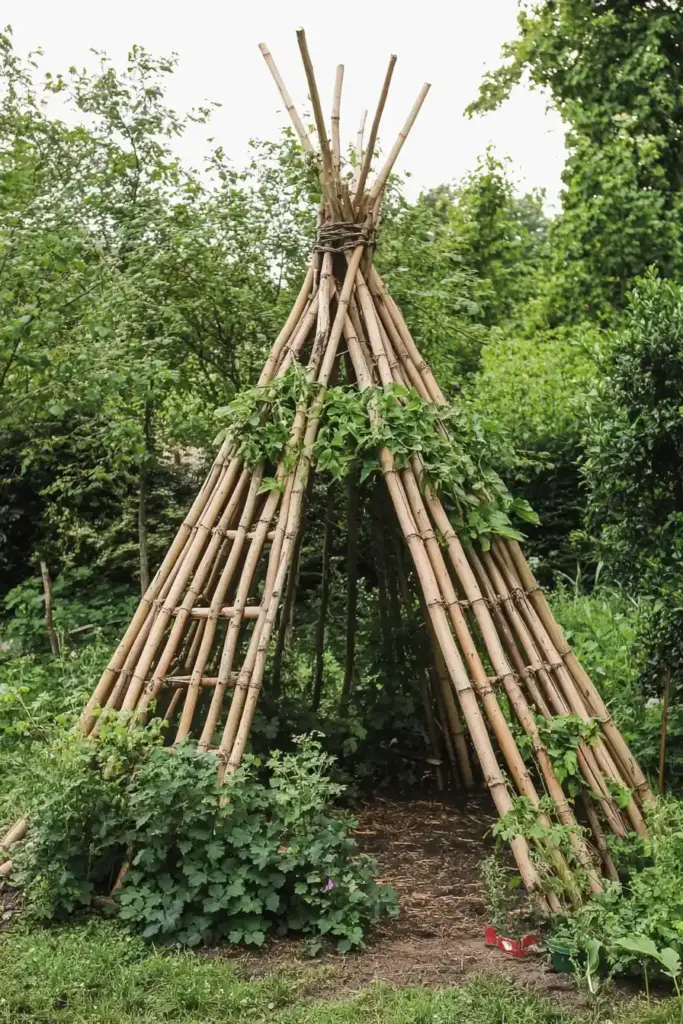
Materials Needed:
- Bamboo poles (5–7 feet long)
- Garden twine or zip ties
- Optional: Scissors, pruning shears
Why It Works:
A bamboo teepee trellis is a time-tested solution that blends seamlessly into any garden. It’s one of the easiest trellises to build—just gather three or more bamboo poles, tie them together at the top, and spread the legs out to form a stable tripod. Wrap twine around the structure horizontally to create more support points for your plants.
Ideal for beans, peas, and other light climbers, this trellis also works great in raised beds or container gardens. It’s super portable, eco-friendly, and adds a rustic, earthy vibe that fits right into a natural garden aesthetic.
Pro Tip: Use additional horizontal twine midway up the poles for extra climbing grip and plant stability as they grow.
9. Rustic Branch Trellis
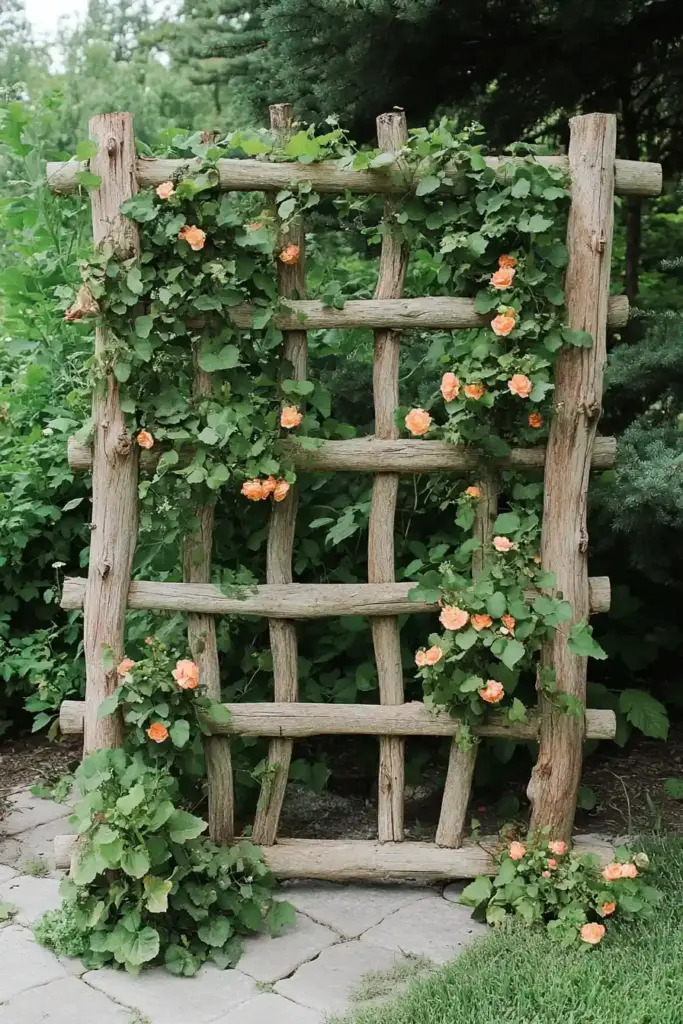
Materials Needed:
- Long, straight branches or saplings
- Garden twine, wire, or zip ties
- Pruners or saw (to trim branches to size)
Why It Works:
If you love the look of a wild, woodland garden, this trellis is your perfect match. Made entirely from foraged branches, a rustic branch trellis blends beautifully into the natural landscape while giving your climbing plants a reliable structure to grow on.
You can build it freeform—leaning branches teepee-style—or create a panel by tying horizontal crosspieces to two upright branches. It’s great for delicate climbers like clematis or nasturtiums and works just as well nestled in garden beds as it does along fences.
Pro Tip: Strip the bark from the lower ends of the branches before anchoring them into the ground to help prevent rot.
10. Classic Wooden Lattice Trellis

Materials Needed:
- Wooden strips (1×2 or 1×3)
- Screws or nails
- Saw, drill, measuring tape
- Optional: Outdoor paint or wood stain
Why It Works:
Nothing says “garden charm” like a classic wooden lattice trellis. With its criss-cross pattern and customizable size, this design is as versatile as it is beautiful. It offers plenty of surface area for climbers to grab onto, making it perfect for everything from roses and honeysuckle to cucumbers and grapes.
You can mount it to a wall, set it freestanding with posts, or even use it as a privacy screen. Whether painted white for a cottage vibe or stained for a more natural look, lattice adds elegance and structure to any outdoor space.
Pro Tip: Seal the wood with an outdoor-grade finish to protect it from weather and extend its lifespan.
Conclusion
Adding a trellis to your garden isn’t just about guiding your plants upward—it’s about elevating your entire outdoor space. Whether you’re working with a small patio or a sprawling backyard, these DIY trellis ideas prove that you don’t need a big budget or professional skills to create something beautiful and functional.
From rustic branches to repurposed bicycle wheels, each design offers its own unique charm and practical benefits. With the right trellis, you can boost plant health, make harvesting easier, and add vertical interest that draws the eye and defines your garden’s character.
So grab your tools, tap into your creativity, and let your garden grow—up!


